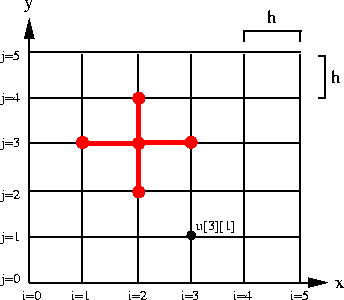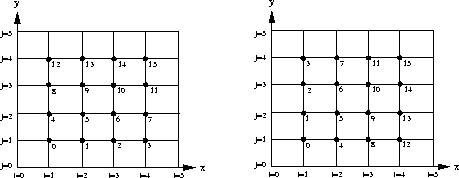| (1) |
In class, we discussed the solution of the following problem
(called the Helmholtz Problem): Find u(x,y) such that
| (1) |
| (2) |
Assume we have created an equispaced grid (xi,yj) where
![]() and grid spacing h (see figure
and grid spacing h (see figure ![]() ). For notational
simplicity, let uij and fij denote
u(xi,yj)and
f(xi,yj) respectively.
). For notational
simplicity, let uij and fij denote
u(xi,yj)and
f(xi,yj) respectively.
 |
In two dimensions, we can approximate
![]() using
finite differencing by the following formula:
using
finite differencing by the following formula:
We can evaluate
![]() and f(x,y) as
and f(x,y) as
![]() and fij respectively yielding the following approximation of
the Helmholtz problem evaluated at the point (xi,yj):
and fij respectively yielding the following approximation of
the Helmholtz problem evaluated at the point (xi,yj):
Following the book, we simplify by multiplying the expression by -h2 yielding:
Observe that we do not need to solve u(x,y) at the boundary
because the value is given explicitly in the problem. Hence
we only need to solve for those grid points interior to the
domain. Because our goal is to form a system of the form
![]() ,
we must now enumerate the interior grid points
as in figure
,
we must now enumerate the interior grid points
as in figure ![]() .
.
 |
Using a row-wise ordering and the fact that we know the solution
at the boundaries, we form the matrix system
![]() given
in figure
given
in figure ![]() .
.
In class, we presented two means of solving this system: Jacobi Method and the (Preconditioned) Conjugate Gradient Method.